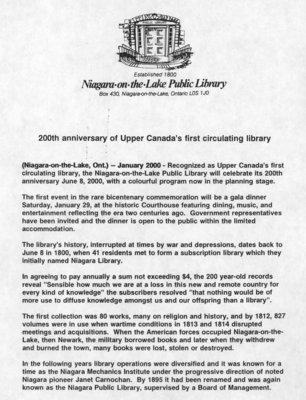Niagara-on-the-Lake Public Library. Established 1800
Niagara-on-the-Lake, Ontario. January 2000.
Recognized as Upper Canada's first circulating library, the Niagara-on-the-Lake Public Library will celebrate its 200th anniversary June 8, 2000, with a colourful program now in the planning stage.
The first event in the rare bicentenary commemoration will be a gala dinner Saturday, January 29, at the historic Courthouse featuring dining, music, and entertainment reflecting the era two centuries ago. Government representatives have been invited and the dinner is open to the public within the limited accommodation.
The library's history, interrupted at times by war and depressions, dates back to June 8 in 1800, when 41 residents met to form a subscription library which they initially named Niagara Library.
In agreeing to pay annually a sum not exceeding $4, the 200 year-old records reveal "Sensible how much we are at a loss in this new and remote country for every kind of knowledge" the subscribers resolved "that nothing would be of more use to diffuse knowledge amongst us and our offspring than a library".
The first collection was 80 works, many on religion and history, and by 1812, 827 volumes were in use when wartime conditions in 1813 and 1814 disrupted meetings and acquisitions. When the American forces occupied Niagara-on-the-Lake, then Newark, the military borrowed books and later when they withdrew and burned the town, many books were lost, stolen or destroyed.
In the following years library operations were diversified and it was known for a time as the Niagara Mechanics Institute under the progressive direction of noted Niagara pioneer Janet Carnochan. By 1895 it had been renamed and was again known as the Niagara Public Library, supervised by a Board of Management.
By 1999, the library had a collection of 46,000 books, periodicals, videotapes and microfilm titles; public access Internet stations and a membership of 10,000.
One of the special features in 2000 includes working with the Mackenzie Heritage Printery in heritage printing production and displays. The annual exhibit at the Queenston museum will trace the production of book publishing from Gutenberg to the bicentenary of the Niagara Public Library.



